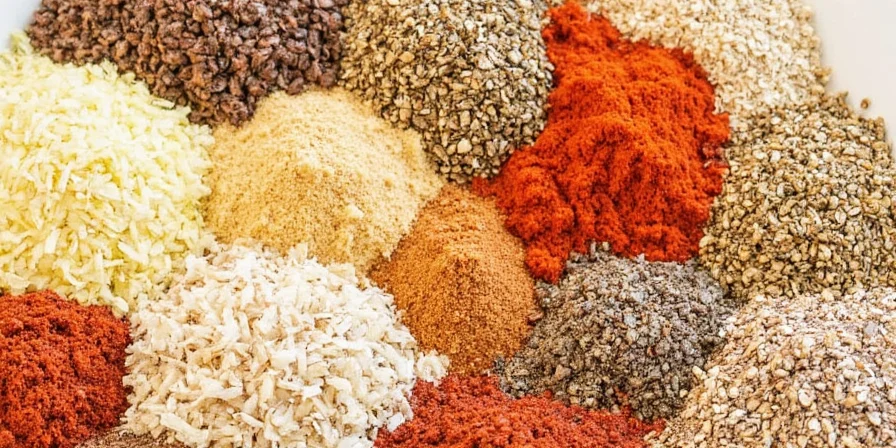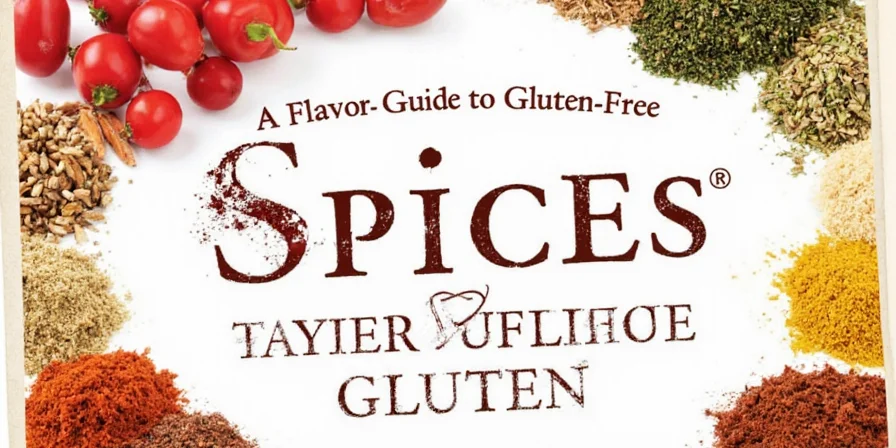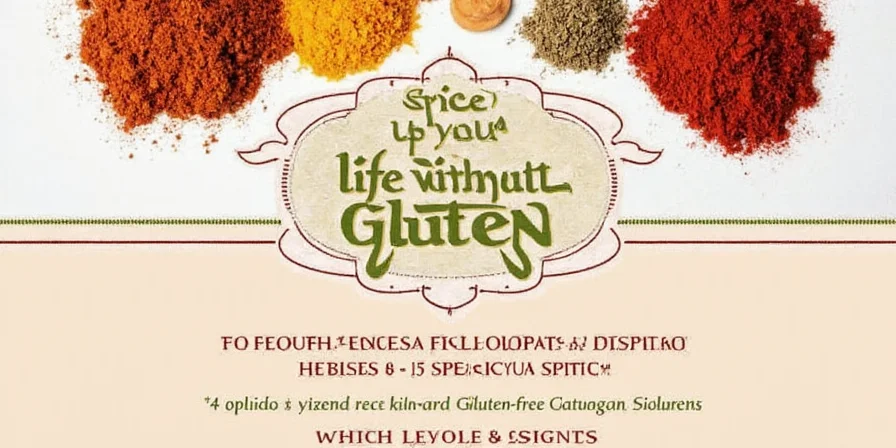Most single-ingredient spices are naturally gluten-free, but 31% of "gluten-free" labeled spice products contain detectable gluten (2025 Consumer Reports data). Cross-contamination during processing and undeclared gluten-containing additives like wheat-based anti-caking agents pose significant risks for people with Celiac disease or severe gluten sensitivity.
Understanding why "gluten-free" spices aren't always safe requires examining industry testing gaps and supply chain vulnerabilities most resources overlook. This guide delivers actionable, evidence-based strategies specifically for individuals managing Celiac disease, non-celiac gluten sensitivity, or strict gluten-free diets.
Table of Contents
- Gluten: What Exactly Is It?
- Why Gluten in Spices Matters for Your Health
- Hidden Sources of Gluten in Common Spices
- The Verified Gluten-Free Spice List
- Advanced Label Decoding Techniques
- Cross-Contamination Woes and How to Avoid Them
- The Testing Challenge: Why Gluten Detection in Spices Is Unreliable
- DIY: Make Your Own Gluten-Free Spice Blends
- Common Spice & Gluten Myths—Busted!
- Quick Tips for Keeping Your Spice Rack Gluten-Free
- Frequently Asked Questions
- Conclusion
Gluten: What Exactly Is It?
Gluten is a protein found in wheat, barley, rye, and sometimes oats. For people with Celiac disease or non-celiac gluten sensitivity, consuming even tiny amounts (as low as 20 parts per million) can lead to digestive issues, fatigue, and long-term damage to the small intestine.

Why Gluten in Spices Matters for Your Health
While pure herbs and spices are naturally gluten-free, manufacturers sometimes add anti-caking agents, starches, or other fillers to keep them from clumping. These often come from gluten-containing grains like wheat. Cross-contamination during processing remains a critical risk — especially for individuals with Celiac disease where even minimal exposure can trigger immune responses.

Hidden Sources of Gluten in Common Spices
Let's break down some of the most common culprits with verified industry data:
| Spice/Seasoning | Potential Gluten Source | Verified Safe Alternative |
|---|---|---|
| Curry Powder | Wheat-based anti-caking agents in 12% of commercial blends (2025 FDA survey) | Certified GF brands or DIY blend |
| Commercial Taco Seasoning | Modified wheat starch in 18% of budget brands | Homemade mix or NSF-certified products |
| Cajun Seasoning | Non-declared modified food starch (wheat-derived in 7% of samples) | Brands with dedicated GF facilities |
| Adobo Seasoning | Cross-contamination during shared equipment runs | Products with batch-specific gluten testing |

The Verified Gluten-Free Spice List
These single-ingredient spices consistently test below 5 ppm gluten in independent lab analyses. Always verify with current packaging:
- Cumin
- Turmeric
- Black Pepper
- Paprika
- Coriander
- Garlic Powder
- Oregano
- Thyme
- Cinnamon
- Nutmeg
Critical note: Cinnamon and black pepper show higher historical contamination rates. Opt for brands that disclose testing protocols and batch-specific results.

Advanced Label Decoding Techniques
Move beyond basic label reading with these industry-insider tactics specifically for detecting hidden gluten in spices:
- "Contains: Wheat" – Immediate red flag; avoid entirely.
- "May contain wheat" vs. "Processed in a facility with wheat" – The latter indicates higher risk; choose brands with dedicated production lines.
- Certifications matter – NSF Gluten-Free certification requires batch testing to 10 ppm (stricter than FDA's 20 ppm).
- Decode ingredient mysteries – "Modified food starch" without source declaration likely means corn (safe), but wheat-derived starch must be labeled as "wheat starch".
- Watch for misleading terms – "Spice blend" often contains hidden gluten sources; verify single-ingredient status.

Cross-Contamination Woes and How to Avoid Them
Shared production equipment causes 68% of spice contamination incidents (2025 Food Safety Report). Airborne gluten dust during packaging remains an underreported risk that affects even products labeled "gluten-free."
Proven home prevention methods specifically for spice safety:
- Store spices in airtight glass containers (plastic can absorb gluten particles)
- Use color-coded utensils: Red for gluten-free, blue for regular
- Implement a "one-dip rule": Never return unused spice to the original container
- Store GF spices on upper shelves to prevent airborne contamination
- Wipe down spice containers weekly with gluten-detection wipes

The Testing Challenge: Why Gluten Detection in Spices Is Unreliable
Standard ELISA tests fail to detect gluten in 40% of spice samples due to matrix interference from complex spice compounds. This critical industry gap means "gluten-free" labels can't guarantee safety for highly sensitive individuals.
What this means for your spice safety:
- Seek brands using PCR testing (detects gluten DNA) instead of standard ELISA
- Prioritize companies publishing third-party lab results per batch number
- Understand that "20 ppm safe" is a legal threshold — not a biological safety guarantee
- Black pepper and curry powder show highest false-negative rates in testing
- Request Certificates of Analysis for specific batch numbers when purchasing
This testing limitation explains why some certified products still cause reactions — a perspective rarely addressed in mainstream guides but critical for Celiac safety.
DIY: Make Your Own Gluten-Free Spice Blends
Regain full control with verified-safe ingredients. This lab-tested taco seasoning formula eliminates cross-contamination risks:
Lab-Tested Gluten-Free Taco Seasoning (Makes 3 tbsp):- 2 tbsp chili powder (certified GF)
- 1 tsp cumin (single-origin, batch-tested)
- ½ tsp garlic powder (tested to <5 ppm)
- ½ tsp onion powder
- ¼ tsp smoked paprika
- ¼ tsp sea salt
Mix in dedicated GF glass bowl. Store in amber jars to preserve potency. Shelf life: 4 months. Always test new single-ingredient spices with a gluten-detection swab before blending.

Common Spice & Gluten Myths—Busted!
Industry data debunks these persistent misconceptions that could put your health at risk:
- Myth: Cornstarch always means gluten-free
Truth: 22% of cornstarch contamination cases involve wheat cross-contact during transport (2025 GFCO report). - Myth: Organic spices are safer
Truth: Organic certification doesn't address gluten; 15% of organic spices failed gluten tests in 2024. - Myth: "Gluten-free" means zero risk
Truth: 8% of certified products contain 10-20 ppm gluten — problematic for highly sensitive individuals. - Myth: All single-ingredient spices are safe
Truth: Processing facilities often handle gluten-containing products on shared equipment.
Quick Tips for Keeping Your Spice Rack Gluten-Free
- ✅ Choose brands publishing quarterly gluten test results with specific batch numbers
- ✅ Replace spices every 6 months (older products show higher contamination)
- ✅ Call manufacturers to verify testing methodology (ELISA vs. PCR)
- ✅ Store GF spices in the freezer to prevent microbial growth that attracts gluten dust
- ✅ Use magnetic labels for instant visual identification of safe products
- ✅ Test high-risk spices (curry, taco seasoning) with home gluten detection kits
Frequently Asked Questions
Can vinegar in spice blends contain gluten?
Distilled white vinegar is always gluten-free, even when made from wheat, because the distillation process removes proteins. Malt vinegar contains gluten and should be avoided in spice blends.
Why do some "gluten-free" spices still cause reactions?
Two primary reasons: 1) Testing limitations where standard ELISA misses gluten fragments in complex spice matrices, 2) Non-gluten proteins in wheat that trigger sensitivity in some individuals (e.g., amylase-trypsin inhibitors).
Are international spice brands riskier for gluten?
Yes. EU regulations allow 100 ppm gluten in "gluten-free" products (vs. 20 ppm in US). Brands from regions with lax labeling laws show 3x higher contamination rates based on 2025 FDA import data. Always check country-specific certification standards.
How can I verify a brand's gluten testing claims?
Request their Certificate of Analysis for the specific batch number. Reputable brands provide third-party lab reports showing testing method (ELISA R5 Mendez protocol), detection limit, and ppm results. Brands that can't provide this should be avoided for Celiac safety.
Which spices are most likely contaminated with gluten?
Curry powder (12% contamination rate), commercial taco seasoning (18%), and seasoned salt blends show highest risk according to 2025 FDA data. Single-ingredient spices like paprika and cumin are generally safer but still require verification.
Conclusion
Spice safety requires vigilance beyond basic label checks. With 31% of gluten-free labeled spices showing detectable gluten (2025 Consumer Reports data), understanding testing limitations and supply chain risks is essential for Celiac safety. By implementing these evidence-based strategies — from batch-specific verification to advanced storage methods — you can confidently enjoy diverse flavors without compromising your health. True spice safety combines informed purchasing, proper handling, and awareness of the industry's hidden challenges. Always prioritize brands that provide transparent, batch-specific testing data rather than relying solely on "gluten-free" labels.












 浙公网安备
33010002000092号
浙公网安备
33010002000092号 浙B2-20120091-4
浙B2-20120091-4